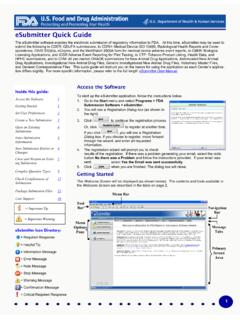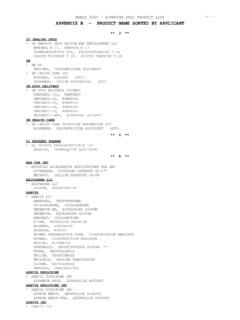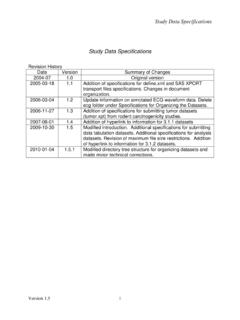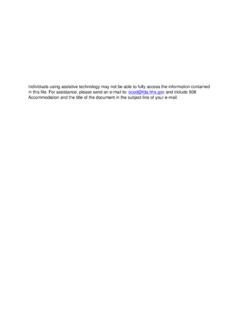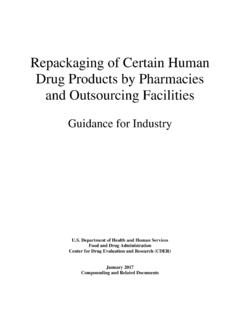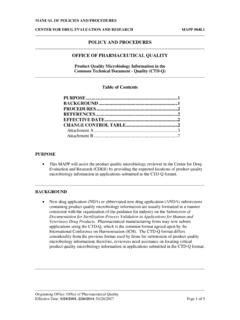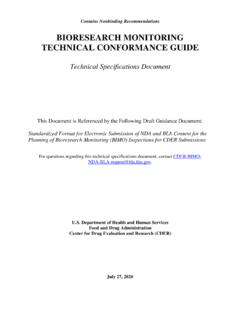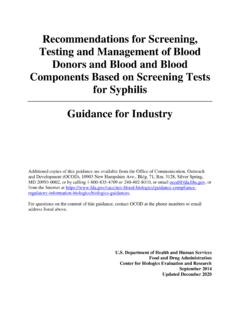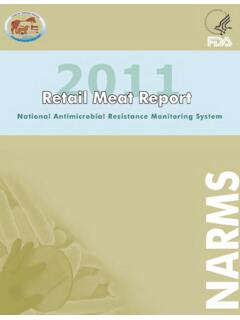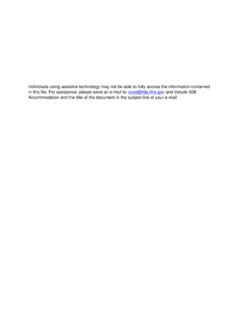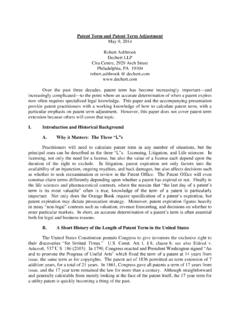Transcription of Inside This Issue Patents and Exclusivity
1 Patents and Exclusivity MAY 19TH, 2015 Inside This Issue A. Patents 1. Definition 2. Submission Requirements B. Exclusivity 1. Orphan Drug Exclusivity 2. New Chemical Entity 3. Other Exclusivity 4. Pediatric Exclusivity 5. 180-Day Exclusivity C. CDER Exclusivity Board Did you know that patent and Exclusivity are two of the most commonly searched terms on the FDA website? Generics account for more than 80% of prescription drugs in the US, and that number continues to grow. With approaching patent expirations of several top selling prescription brand-name drugs, sponsors of innovator drug products and generic manufacturers need to know the ins and outs of Patents and Exclusivity .
2 Patents . A patent is a property right issued by the United States patent and Trademark Office (USPTO) to an inventor to exclude others from making, using, offering for sale, or selling the invention throughout the United States or importing the invention into the United States for a limited time, in exchange for public disclosure of the invention when the patent is granted. Generally, the term of a new patent is 20 years from the date on which the application for the patent was filed in the United States. A company may apply for a patent from the USPTO anywhere along the development lifeline of a drug and can encompass a wide range of claims. However, many other factors can affect the duration of a patent .
3 patent information is required to be submitted with original new drug applications (NDAs) and supplements on FDA Form 3542a prior to approval. Post-approval, patent information should be submitted on FDA Form 3542. The information from FDA Form 3542 is published in the Orange Book (Approved Drug Products with Therapeutic Equivalence Evaluations). For Patents issued after approval of the NDA, the applicant holder has 30 days in which to file the patent to have it considered as a timely filed patent . Patents may still be submitted beyond the 30 day timeframe but the patent is not considered a timely filed patent . Abbreviated new drug application (ANDA) holders are not required to make a certification to an untimely filed patent if the generic application is submitted before the patent .
4 FDA will not publish in the Orange Book patent information on unapproved applications or on Patents beyond the scope of the Food Drug & Cosmetic Act ( , process or manufacturing Patents ). The Patents that FDA regards as covered by the statutory provisions for submission of patent information are: Patents that claim the active ingredient(s); drug product Patents which include formulation/ composition Patents ; use Patents for a particular approved indication or method of using the product; and certain other Patents as detailed on FDA Form 3542. Exclusivity . Exclusivity is exclusive marketing rights granted by the FDA upon approval of a drug and can run concurrently with a patent or not.
5 It prevents the submission or effective approval of ANDAs or applications described in Section 505(b)(2) of the Act, and was designed to promote a balance between new drug innovation and generic drug competition. Exclusivity is granted upon approval of a drug product if the statutory requirements are met. The length of time that FDA grants new drug Exclusivity depends on the type of Exclusivity . Note that Exclusivity is not added to the patent life. Hatch Waxman Exclusivity (5-year, 3-year, and 180-day) is described in 21 There are four types of Exclusivity that fall under the NDA statutory requirements: PAGE 2 1. Orphan Drug Exclusivity (ODE) - 7 years: Granted to drugs designated and approved to treat diseases or conditions affecting fewer than 200,000 in the (or more than 200,000 and no hope of recovering costs) Runs from time of approval of NDA or BLA Bars FDA from approving any other application (ANDA, 505(b)(2) or full NDA or BLA) for the same drug for thesame orphan disease or condition for seven years Covered under the Orphan Drug Act and 21 CFR 2.
6 New Chemical Exclusivity (NCE) - 5 years: Granted to a drug that contains no active moiety that has been approved by FDA under section 505(b) Runs from time of NDA approval Bars FDA from accepting for review any ANDA or 505(b)(2) application for a drug containing the same active moiety for: - five years if an ANDA or 505(b)(2) does not contain a paragraph IV certification to a listed patent - four years if an ANDA or 505(b)(2) is submitted containing a paragraph IV certification to a listed patent Described in 21 CFR 3. "Other" Exclusivity - 3 years for a "change" if criteria are met: Granted to drug when application or supplement contains reports of new clinical investigations (not bioavailability studies) conducted or sponsored by applicant and essential for approval Runs from time of NDA approval Bars FDA from approving, for a three year period, any ANDA or 505(b)(2) application that relies on the information supporting the approval of the drug or the change to the drug for which the information was submitted and the Exclusivity granted Described in 21 CFR 4.
7 Pediatric Exclusivity (PED) - 6 months added to existing Patents / Exclusivity Grants an additional 6 months of market protection at the end of listed Patents and/or Exclusivity for sponsor s drug products containing the active moiety, when the sponsor has conducted and submitted pediatric studies on the active moiety in response to a Written Request from FDA Pediatric Exclusivity takes on characteristics of five year, three year or orphan Exclusivity when it attaches to those protections. Described in the Best Pharmaceuticals for Children Act (BCPA) and Section 505(A) of the Food and Drug Administration Modernization Act of 1997. PAGE 3 Note also that under the Generating Antibiotic Incentives Now (GAIN) Title VIII of the FDA Safety and Innovation Act (FDASIA), at the time of approval FDA will grant an additional five years to certain Exclusivity periods for products that have been granted a Qualified Infectious Disease Product (QIDP) designation (with some exceptions).
8 5. 180-Day Exclusivity : FDA may also grant Exclusivity to abbreviated new drug applications (ANDAs) for generic drugs. Under the Drug Price Competition and patent Term Restoration Act, or the Hatch-Waxman Act, a company can seek approval from FDA to market a generic drug before the expiration of a patent relating to the brand name drug upon which the generic is based. The first company to submit an ANDA with the FDA has the exclusive right to market the generic drug for 180 days. This is called 180-day Exclusivity . Provides an incentive of 180 days of market Exclusivity to the "first" generic applicant who challenges a listed patent by filing a paragraph IV certification and running the risk of having to defend a patent infringement suit Begins either from the date the sponsor begins commercial marketing of the generic drug product, or from the date of a court decision finding the patent invalid, unenforceable or not infringed, whichever is first In some circumstances, an applicant who obtains 180-day Exclusivity may be the sole marketer of a generic competitor to the innovator product for 180 days FDA does not send letters to the sponsor indicating the grant of Exclusivity .
9 The Orange Book is the official vehicle for dissemination of this information. Note that some drugs have both patent and Exclusivity protections while others have just one or none. Patents and Exclusivity may or may not run concurrently and may or may not encompass the same claims. CDER Exclusivity Board: CDER has established an Exclusivity Board to provide oversight and recommendations regarding Exclusivity determinations made by the Center, with a primary focus on clarity and consistency of decisions. The CDER Exclusivity Board oversees certain Exclusivity determinations, including whether and what type of Exclusivity should be granted and the appropriate scope of Exclusivity grants.
10 The Board will focus on 5-year new chemical entity (NCE) Exclusivity , 3-year new clinical trial Exclusivity , and Exclusivity for biological products. The Board will not review or make recommendations with respect to all Exclusivity determinations in these areas, but will assist the Center in resolving certain matters, including issues that arise in the context of specific requests for Exclusivity . So there you have it Patents and Exclusivity simplified. Until next time, Renu Lal, CDER Small Business and Industry Assistance Issues of this newsletter are archived at This communication is consistent with (k) and constitutes an informal communication that represents our best judgment at this time but does not constitute an advisory opinion, does not necessarily represent the formal position of the FDA, and does not bind or otherwise obligate or commit the agency to the views expressed.
